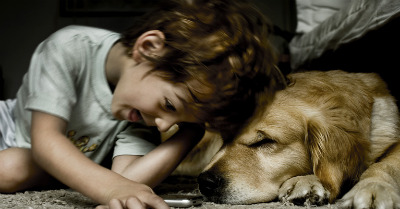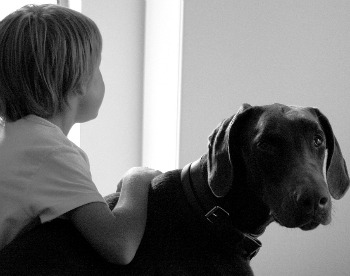|
Kids and DogsIf you have children, before you adopt a dog, you must consider the relationship between kids and dogs. Although it may seem logical to adopt a small dog because children are more easily able to care for a small dog, this may not be the best idea. Small dogs can be fragile and easily hurt. Now, if you adopt a puppy, the dog will start out small and this is when you need to teach your children how to properly handle your dog. A puppy is fragile. You must teach your child to be careful when picking up the dog so they don't drop him accidentally. Even if you don't own a dog, you need to teach your children from a very early age how to behave around a dog. As soon as my children could walk, they were interested in petting every dog they saw. They wanted to run right up to every dog, putting their little faces right in line with a dog's muzzle, a possibly dangerous thing to do. I first taught my children to only approach dogs when they were with their owner, and secondly, to never pet the dog without first asking the owner’s permission. When my children were very young I also taught them to pet a dog gently and to never tug on a dog or pull its tail. Never let your children tease a dog. Also, teach your children not to scream or make sudden movements around a dog, as this may startle the dog and cause him to bite. These are simple things you can and should do, for the safety of both the child and the dog. Puppies need to be socialized around children. Take your puppy for frequent walks where he can get used to all sorts of people. Walking the puppy by a school or playground can help as well. The more exposure your puppy has to children, the quicker he will learn that children are not a threat. If you follow these simple instructions the chance of your child being bitten by a dog decreases, obviously our goal when we think about kids and dogs.

Photo by Cia de Foto via Flickr
Preventing Dog BitesBy teaching young children about a dog's warning signs - that he is disturbed and possibly ready to bite, you can do your part to help prevent dog bites. This not only protects your child, but protects your dog as well. Many dogs end up in shelters because they've bitten a child that was not taught how to act around a dog. If a dog feels threatened, even if only in his own mind, he might react by biting. Any time a dog growls, your child needs to be taught to quietly walk away. A dog that is approached by a small child that does not want to be bothered may simply walk away himself. Teach your child not to follow the dog. The dog has already given his warning that he does not want the child around him. When children rough house with a dog, the dog will instinctively use his teeth, just as he would when playing with another dog. Again, you can decrease the chance the dog will bite by teaching your child not to play roughly with your dog. Never leave a small child alone with your dog. Even if a dog has never shown aggression in the past, a small child may unintentionally provoke a dog. As the adult, it is up to you to keep your child safe.
Photo by Coda Allegra via Flickr
Choosing a DogIf you have small children, do you really have time for a dog? After all, caring for a puppy is almost like caring for another child. And if you adopt an adult dog, are you able to give the dog the proper attention he needs? Do you have time to socialize your dog and train him, and teach your children how to act around the dog? If you intend to purchase a purebred, be certain to buy from a reputable, responsible breeder who puts priority on breeding dogs with good temperaments. Any good breeder will have this goal in mind when breeding. You must be willing to teach both your kids and dogs how to act around each other. If you adopt a dog from a shelter, make sure you get as much background on him as possible. Did he live with children? Why was he given away? Not because he bit a child, right? Something else extremely important to remember with kids and dogs, is that your dog may put up with things from his own kids, but not from your kids' friends or the neighbors’ kids. When children visit, be extra cautious. Remember, other children may not have been taught how to properly behave around a dog. If in doubt, put your dog away somewhere that keeps both him and the kids safe. Be sure you research what breeds of dogs are best around children. Obviously, there are some dogs that are much more tolerant and easy going. That's the kind of dog you want around your children. Remember, adults need to be responsible in teaching their children how to behave around dogs. Responsible adults and pet owners will decrease the number of children bitten and fewer dogs will be euthanized for behavior considered aggressive that was in reality just an instinctual reaction to what the dog perceived as a threat. Kids and dogs are meant to be together, but they need to be in a situation that is safe for both of them. Return from Kids and Dogs to Choosing a Dog
|






